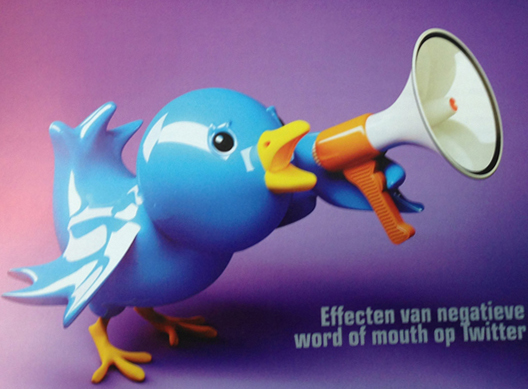Le Pair, R.G. le & Van Dongen, M. (2013)
Effecten van negatieve word of mouth op Twitter: de invloed van negatieve tweets op merkvertrouwen en op de intentie om de negatieve berichten te vespreiden.
Ad Rem, 27 (6), 3-6.
De kracht van traditionele word-of-mouth communicatie (WOM) is bekend: aankoopbeslissingen, merkvertrouwen, de reputatie van een organisatie of merk worden positief of negatief beïnvloed door wat familie, vrienden en bekenden over een product of dienst zeggen. Het ligt voor de hand te veronderstellen dat dit ook gebeurt bij online word-of-mouth communicatie (eWOM), bijvoorbeeld op websites met product-reviews, vergelijkings-sites, discussie-fora van bedrijfswebsites, binnen brand communities, etc.
Maar hoe groot is de WOM-kracht van zo’n vluchtig platform als Twitter? Dat is nog niet eerder systematisch onderzocht. Marije van Dongen en ik waren nieuwsgierig naar de effecten van negatieve productgerelateerde uitlatingen op Twitter, en Marije deed onderzoek, en samen publiceerden we een artikel in Ad Rem.
Uit ons experimentele onderzoek blijkt:
Negatieve eWOM tweets
- hebben negatief effect op merkvertrouwen;
- leiden tot verspreiding negatieve WOM;
- deskundigheid van de twitteraar wordt herkend; als een deskundige het zegt heeft dat meer impact: het negatieve effect op merkvertrouwen is dan sterker en de neiging om de negatieve word-of-mouth te verspreiden is dan groter.
Pair, R.G. le (2015)
@mentions in klaagtweets aan bedrijven: trigger voor webcare-interactie.
Marketingfacts.nl, 23-1-2015.
Pair, R.G. le (2015)
Webcare: zorgt een ‘human voice’ voor meer interactie? [Onderzoek].
Frankwatching, 9-2-2015.
→ online
Le Pair, R.G. le (2015)
Als de consument het voor het zeggen heeft: over klachtentweets en webcare.
Tekst[Blad], 21 (3), 28-31.
Pair, R.G. le & Dongen, M. van (2016)
Reputatieschade voor een organisatie door negatieve word-of-mouth tweets. In D. van de Mieroop & L. Buysse (Eds.), De macht van de taal. Taalbeheersingsonderzoek in Nederland en Vlaanderen (pp. 191-203). Leuven / Den Haag: Acco
Le Pair, R. & Van Eijk, A. (2018)
Webcare-communicatie: waarom bepaalde tekstkenmerken de interactie beïnvloeden. Paper gepresenteerd op VIOT 2018 Duurzame Taalbeheersing, Groningen, 16-18 januari 2018.
Le Pair, R. & Van Eijk, A. (2018)
@Organisatie in klachtentweets als trigger voor
webcare-interactie. Tijdschrift voor Taalbeheersing (40) 1, 107-135.
DOI: → online
An organization’s webcare is aimed at dealing with as many consumer complaints as possible. The question is what features of negative word-of-mouth tweets lead to more webcare response. From a pragmalinguistic perspective, we started with a brief overview of the speech act of complaining, and its illocutionary force which is communicated directly or indirectly. In two corpus analyses (with 6533 and 1479 negative word-of-mouth tweets), we examined the relations between the way consumers address an organization (operationalized as the position of @Organization in the negative word-of-mouth tweet) and the amount of webcare interaction between the organization and consumers. The results show that when a consumer places the addressed @Organization at the beginning of the tweet, this leads to a webcare-response more frequently than when @Organization occurs elsewhere in the tweet. In the second corpus analysis, the communicative function of @Organization (direct or indirect address) was included in the analysis. When @Organization was addressed directly, this resulted in more webcare interaction than when the organization was addressed indirectly.
Le Pair, R. (2018)
Keynote
Complaint tweets and webcare. What triggers interaction? , Invited Plenary Speaker at Conference: Language in webcare. Interdisciplinary perspectives, 22-23 November 2018, Ghent, Belgium
An organization’s webcare is aimed at dealing with as many consumer complaints as possible. In this contribution, I will raise the question whether linguistic features of negative word-of-mouth tweets may lead to differences in the perception of these complaints, and consequently to differences in webcare response. Our study shows that a pragmalinguistic approach to complaint tweets is helpful in explaining the occurrence of webcare interaction between organizations and complaining consumers. The results of two corpus analyses (with 6533 and 1479 negative word-of-mouth tweets) suggest that the perception of the illocutionary force of the complaint tweet depends both on the position of @Organization in the tweet (at the very beginning or elsewhere in the tweet), and on the direct or indirect way of addressing an organization when realizing the speech act of complaining in a tweet.
When we examine complaints and (the succes of) webcare interaction, it is also important to pay attention to the communication style in webcare. In recent research, the framework for analysing linguistic realizations of a conversational human voice in webcare has been refined and investigated systematically. I will show how some of these linguistic features seem to influence the amount of webcare interaction.
Gerelateerde informatie
Negatieve eWOM tweets hebben negatief effect op merkvertrouwen, leiden tot verspreiding negatieve WOM, en een deskundige heeft meer impact, zo blijkt uit experimenteel onderzoek van Marije van Dongen en mij.


